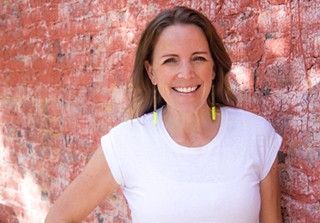Starting tomorrow, that all ends in Oregon—at least for the next four weeks.
Oregon Gov. Kate Brown announced Monday afternoon that she would be issuing an executive order Tuesday, effectively forcing all bars and food service establishments to go to a carry-out and delivery-only model for a four-week time period.

The order, Brown said, will also include new guidelines limiting gatherings to 25 or fewer people, with a "suggestion" to limit gatherings to 10 or less. Grocery, retail and other workplaces will be exempt from that 25-people rule, Brown said.
The moves are intended to force Oregonians into social distancing—or "physical distancing," as mental health officials recommend it be termed. Without more physical distancing to slow the spread of COVID-19, health officials said today that Oregon may not have the number of certified hospital beds it needs to manage the surge of cases that could come in.Based on a model of a doubling in cases every 6.2 days, Oregon will need an estimated additional 1,000 hospital beds and 400 more intensive care beds by April 11 in order to manage the projected surge that could be coming without physical distancing measures, said Oregon Health Science University's Chief Medical Officer Dr. Renee Edwards
tweet this
Those numbers are based on a projection model developed by Dr. Peter Graven of OHSU, Edwards said, along with other state partners. According to OHSU's website, Graven is a a data scientist and an affiliate assistant professor in the School of Public Health.
"Our goal is to prevent that surge," Edwards said Monday.
At the press conference, Oregon Health Authority Director Patrick Allen added, "We will see a significant increase in the number of cases in the next week or so," adding that the OHA and other officials are actively looking at where they can increase bed capacity statewide. Oregon currently has about 6,000 licensed hospital beds in the state, Allen said.
Earlier reporting by the Portland Tribune found that Oregon's per-capita rate of hospital beds is the lowest in the country. It got there, Allen said, "by doing a good job of providing primary care."
When asked whether that low per-capita number is a negative thing now, Allen said, "It's hard to argue we should keep people sicker so we have more beds."
An Economic Task Force
Gov. Brown said today she has convened a Coronavirus Economic Advisory Council, aimed at supporting small businesses and individuals who may be laid off or otherwise face economic hardship as a result of the many closures, though Brown said more details would be available following meetings this week, but that options on the table include more worker's compensation or unemployment insurance options.
"We're looking at all tools," that may be available, Brown said, to help people pay the rent.
Schools may see additional closures, but Brown wasn't ready to make that call at today's press conference.
As for test kits? Oregon still doesn't have enough, officials said today—in part because of a lag from the federal government.
tweet this
Hospitals Working Together
Meanwhile, hospitals across Oregon are preparing for a huge surge in cases needing hospitalization for COVID-19.
Under a new metro regional COVID-19 hospital response plan, hospitals in the Portland metro area will begin working together more closely to help manage the onslaught of patients thought to come in by increasing bed capacity, and will establish a single command center to manage patient care, officials said today.
The governor is also mustering state's Unified Command emergency response under an "All Hazards" command structure to help manage the crisis, in the same way it might be employed for any other catastrophe.
As for test kits? Oregon still doesn't have enough, officials said today—in part because of a lag from the federal government, meaning health providers must continue to prioritize testing just the sickest patients while they wait for more testing capacity to come online at hospitals and more private labs.
Another big issue: Personal protective devices for health care workers. The State has a backstock, Allen of OHA said today, but once that runs out, it's unclear right now whether enough will be available in the U.S. to manage what's ahead.
St. Charles Introduces More Measures
St. Charles Health System also announced today more measures to promote social distancing. Its St. Charles Bend Community Pharmacy now has drive up service, available from 11am to 6pm. Visitor restrictions remain in effect—meaning visitors are not allowed at any of the system's four hospitals. All four hospitals will be using external triage tents outside the Emergency Departments, and caregivers are being screened for cough and fever at the St. Charles Bend facility.
To help prep for a surge in patients, some St. Charles patients may need to be moved. The health system announced today that "high-acuity" patients and pediatric patients will be cared for at the Bend location, with "lower-acuity" and hospice care patients located at the Madras, Prineville and Redmond locations. Those changes will happen this week, and providers are assessing which patients will need to be transferred.
Like all other facilities in the state, testing supplies remain low—so only people with a fever of 100.4 or above with a cough and shortness of breath, along with one of three of the following: 60+ years old/immunosuppression/chronic illness will be tested for COVID-19 at St. Charles facilities.
"Right now, our most urgent priority is keeping our frontline caregivers healthy and our facilities safe and functioning so we can deal with COVID-19 cases, as well as people who come to us with other medical issues," said Joe Sluka, St. Charles Health System President and CEO in a statement Monday.
Private clinics and providers may be able to test others, but people should call ahead to find out what their provider can offer.
This story will be updated.
























